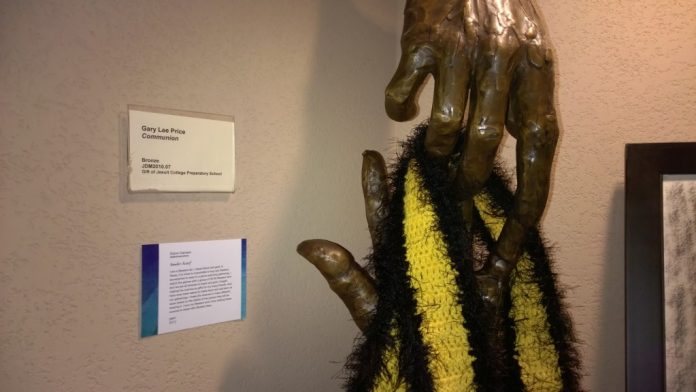How do we respond when we think about and experience the feeling of a touch? Does it entertain our minds with warm and sunny memories of comfort, or does it haunt the mind with the experiences of abuse and violence? Does it represent a welcoming, thorough handshake or a helpful hand, or does it signify a denial? Just as art may evoke contrasting notions of happiness and sadness, depending on the perspective of the individual, Communion by Gary Lee Price provides a basis for a variety of perceptions.
Artist Gary Lee Price of Utah attempts to captivate the human spirit with his artwork, emphasizing multiple spirits through the worldly travels in his life. Research in Germany, France, Israel, Egypt, Guatemala, Mexico, etc. completes his perspective of the world and its people.
In his work, he expresses interest in the use of bronze as evidenced by our version of the Communion work. The larger, primary version of the sculpture resides at the United Methodist Church of Brentwood, Tennessee and stands at fifteen feet, about three times larger than the Jesuit Dallas Museum version. Nevertheless, the piece’s theme of grasping hands, seen in other works of his such as Synergy, Helping Hand, Ascent, Circle of Peace, and Circle of Friends, persists in his career as an artist.
As many who read the Monthly Art Focus know, the focal point of the art is its message. The theme of interlocking/grasping hands carries with it the connotations of “the importance of enduring and positive relationships, and of the need to see and depict humanity in a positive light and on an upward journey,” as Price remarked.
Speculations claim that Price’s focus on the positive side derives from his early childhood at age six, where he lost both parents and later suffered from abuse.
Others identify the bronze sculpture with the excellence of the Jesuit community. Such people are students like sophomore Anthony Fisher ’17, who said that the art depicts the “excellence of the students and faculty and emphasizes that Jesuit is more than just a school.”
Commenting on the hands, Anthony believed that it represents “lifting you up as a person, for when you come to Jesuit as a student,[the community] helps you,” paralleling the perception of Price.
Jesuit Museum Director Elizabeth Hunt Blanc noticed “the openness of the hands” and it symbolizing “your interpretation of the artwork.” This makes sense, since we commonly associate open space as our sandbox world, free to make judgments and formulate opinions as we please. In addition, she tied the bronze brilliance to another aspect of Jesuit: community service and outreach. “It represents giving to others,” Mrs. Blanc stated, as one hand assists one another through the struggling hardships of life, perhaps referencing the hardships Price experienced as six years of age.
However, due to its location at the United Methodist Church of Brentwood, one can argue that the sculpture pays most homage to the idea of Christianity. As the title Communion implies, the hand at the top depicts Jesus inviting the hand below (you) to his side. Moreover, it could even represent the parousia, the moment in time where Jesus descends back to earth for the final judgment. In this scenario, the lower hand belongs to the individual that has performed good deeds in the world and deserves the upper hand of Jesus to deliver him into Heaven.






